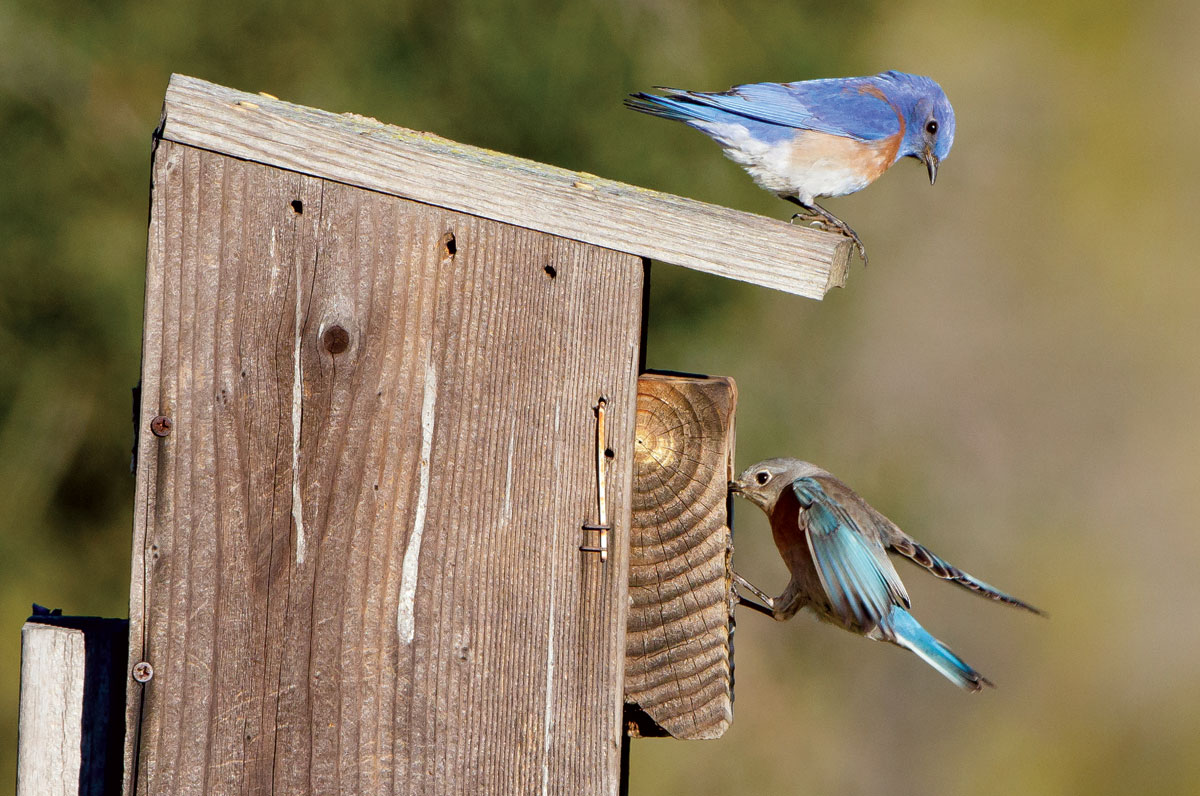People come out of the woodwork to protect bluebirds,” says Earl Swenerton, the volunteer captain of a new bluebird-monitoring program at Lynch Canyon in Solano County. During last year’s nesting season from mid-March to mid-July, 16 volunteers were selected and trained to monitor 40 nesting boxes at Lynch Canyon Open Space, a 1,039-acre property between Vallejo and Fairfield owned by the Solano Land Trust. The final tally for the season of fledged cavity-nesting birds was 23 western bluebirds, 20 tree swallows, and six house wrens. Not bad for a monitoring group considered newly fledged itself compared to several decades-old programs in other parts of the Bay Area.
With the sun’s azimuth still low in the sky, and three months before birds carried their first twigs to nesting boxes, Swenerton and I walked Bluebird Trails #1 and #3 on Lynch Road along the North Fork of Lynch Creek. A bluebird trail is a series of nesting boxes that are monitored for fledgling success (or lack thereof) of western bluebirds and other cavity nesters such as ash-throated flycatchers, violet-green swallows, and house wrens. Though other cavity-nesting birds are welcome, the bluebirds are the star tenants. Male bluebirds are especially showy and provide a brilliant flash of color in the field. Females are less brightly colored and show their patches of blue in quick flashes.
Many of the 40 nest boxes at Lynch Canyon were installed years ago by Cub Scouts and members of the Napa-Solano Audubon Society, but they have not seen regular monitoring or maintenance until now. “Bluebird boxes are a fun and doable project for Scouts,” says Solano Land Trust project manager Sue Wickham. “But they get put up without being maintained.”
Regular maintenance and monitoring are important to protect the eggs and chicks and to increase fledgling counts. Monitors can identify problems and address them. They also take careful notes and share their findings with other groups, which increases the general body of knowledge about cavity nesters.
To establish a monitoring program at Lynch Canyon, Wickham turned to Swenerton, a retired high school science teacher and volunteer docent at several Solano Land Trust properties.
Swenerton knew birds but didn’t know much about starting a bluebird program, so he contacted Bob Brittain in Contra Costa County for guidance. Brittain, a retired chemist, has been stewarding bluebird trails in Walnut Creek for a decade, and he now coordinates an informal group of 12 volunteers who steward and monitor about 10 bluebird trails in Walnut Creek, such as those at Acalanes Ridge Open Space, Old Borges Ranch, and Shell Ridge. In 2014, his bluebird team counted 164 fledged bluebirds on these trails.

When Swenerton asked Brittain to attend a training session for Solano Land Trust volunteers, Brittain was happy to jump the county line and share what he has learned, including how to build a bluebird box from one five-foot length of redwood plank. Brittain has learned to provide partial shade for the boxes and to place them in a transition zone between woods and meadow so that chicks can practice flying and hunting on nearby vegetation. He says his current preferred box design has a slanted roof for rain runoff, as well as side and top panels that hinge open. All panels must be closed securely with drywall screws when not being tended by monitors, to keep out snakes, raccoons, and other predators.
A trail monitor’s tool kit contains more than just a Phillips-head screwdriver. The monitors also carry drywall screws, a flyswatter, a paint scraper to clean out the box, diatomaceous earth to be used as an insecticide, and lye soap to deter wasps from building nests. Volunteers may also carry a measuring tape and a smartphone to determine gps coordinates and the direction the box faces. After just one year the Solano Land Trust crew has learned that the boxes with the most fledgling success face east or south away from prevailing winds; have round entry holes measuring one and nine-sixteenths of an inch; and measure six inches from the bottom of the hole to the floor of the box. If the box is too shallow predators can reach the chicks. If it’s too deep the chicks can’t crawl out. To make the house just right, the box builders carve little grooves on the inside for the chicks to stepladder their way out.
Not all nesting boxes are alike. The Lynch Canyon boxes are mounted on posts, while Santa Clara Valley Audubon Society’s Cavity Nesters Recovery Program advocates hanging nest boxes from trees. According to Santa Clara Valley Audubon coordinator Toby Goldberg, this “robust” program has about 50 volunteers to monitor its boxes. It began in 1997 with 230 boxes on 17 trails and has grown to support 1,300 boxes on at least 100 trails. As of September 2014, volunteers reported 1,134 fledged western bluebirds—about six times the number of boxes, and nearly 13 times as many birds since they began.
Each region continues to learn and adapt its methods to changing conditions. For example, Brittain notes that he and his team have seen more predation and loss of birds since the drought began. Everyone involved will be looking for ways to help the birds fledge as the drought continues.
For the 2015 spring season Swenerton is recruiting and training more volunteers, adding new boxes, and expanding the program to Rush Ranch Open Space. “I didn’t expect such an emotional involvement from the volunteers,” Swenerton says. During the nesting season, the monitors kept watch as the bluebirds built nests, laid and incubated the tiny blue eggs, and fledged their young. “The volunteers developed a personal attachment to the birds and to their trails,” says Swenerton, who saw 100-percent return participation from his teams. He hopes to see that, and more, from the bluebirds, this spring and in years to come.
Aleta George is a frequent contributor to Bay Nature and the author of a new biography, Ina Coolbrith: The Bittersweet Song of California’s First Poet Laureate. Learn more at inacoolbrith.com



